#Sharepoint application development
Explore tagged Tumblr posts
Text
Organizations that require a dependable method to handle requests, monitor problems, and enhance internal communication must have a ticketing system. SharePoint, a popular platform for collaboration and document management, offers a flexible solution for building a custom ticketing system. This blog outlines the reasons why SharePoint is a good choice for this purpose and provides a detailed, step-by-step guide to implementing a ticketing system on the platform.
The blog begins by explaining the benefits of using SharePoint for ticket management. With its ability to centralize data, SharePoint allows businesses to keep track of issues from submission to resolution in one location. This improves organization, ensures better visibility, and makes it easier for teams to stay on top of requests. SharePoint also supports automation, which helps reduce manual effort in assigning tasks, sending updates, and closing tickets. By integrating with other tools like Power Automate, businesses can streamline workflows and create efficient processes that save time and reduce errors.
Next, the blog walks readers through the practical steps of setting up a ticketing system in SharePoint. This includes creating custom lists to capture essential ticket details such as issue type, priority, and status. The guide explains how to design automated workflows to route tickets to the right people, send notifications, and generate reports. A user-friendly interface is also discussed to ensure that employees or customers can easily submit and track their requests.
For businesses looking to develop a more robust solution, SharePoint app development offers a way to create mobile-friendly ticketing systems. With SharePoint application development, teams can manage tickets from anywhere, improving responsiveness and flexibility. Partnering with a skilled SharePoint development company ensures that the ticketing system is built according to the business’s specific needs and integrates well with other systems.
For organizations switching from legacy systems, SharePoint migration services can simplify the transition. These services help ensure that data is moved smoothly to SharePoint without loss, allowing businesses to maintain continuity and avoid disruptions.
By the end of the blog, readers will have a clear understanding of how to use SharePoint for creating a ticketing system that meets their needs. Whether through SharePoint development services or custom solutions, the guide provides practical steps to enhance issue management and improve overall operational efficiency.
#dynamics 365 sharepoint integration#sharepoint and salesforce integration#sharepoint app development#sharepoint application development#sharepoint consulting#sharepoint consulting services#sharepoint developers#sharepoint development company#sharepoint development service#sharepoint migration services#sharepoint services#sharepoint to sharepoint online migration#sharepoint expert consultant#sharepoint integration services#sharepoint intranet development#sharepoint migration consultant#sharepoint service provider#sharepoint solution provider
0 notes
Text
#sharepoint intranet#sharepoint onboarding app#uses for sharepoint#sharepoint design#sharepoint consulting services#sharepoint support#power pages sharepoint#sharepoint solutions#sharepoint application development
0 notes
Text
Unlock Business Insights with TeBS - Your Trusted Power BI Implementation Partner!
Harness the full potential of Microsoft Power BI with TeBS, your premier partner for data-driven success. Our expert team tailors solutions to your unique enterprise requirements, enabling you to analyze data, derive actionable insights, and drive growth. Elevate your business intelligence journey today.
Explore more: Power BI Partner Dashboard
#total ebiz solutions#sharepoint application development#project management software#Trusted Power BI Implementation#Trusted Power BI Implementation Partner
0 notes
Text
#software#projects#tech#technology#it staff augmentation#web devlopment#app development#enterprise application development#enterprise app development company#enterprise application services#sharepoint development services#abby finereader engine#document management services#microsoft azure services
2 notes
·
View notes
Text
From Concept to Launch: How SharePoint Application Development Works
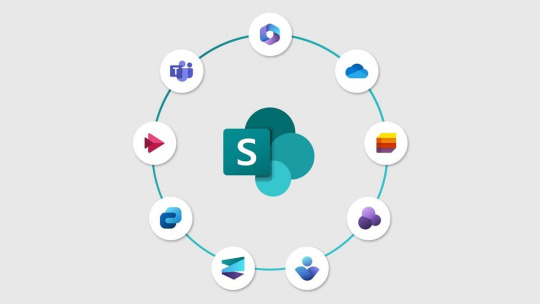
In the modern business environment, efficiency, collaboration, and streamlined operations are more crucial than ever. Organizations increasingly rely on digital platforms to centralize processes, manage content, and enhance productivity. Among these platforms, Microsoft SharePoint stands out—not just as a content management system but as a powerful application development framework.
With custom SharePoint application development, businesses can build tailored solutions that fit unique workflows, automate routine tasks, and seamlessly integrate with other Microsoft 365 tools. But how does it work? What’s involved in transforming an idea into a fully functional SharePoint app?
In this article, we walk you through the complete journey—from concept to launch—of developing a SharePoint application, and how this process delivers scalable, secure, and user-centric digital solutions.
Why Build a SharePoint Application?
Before diving into the process, let’s look at why businesses choose SharePoint for application development:
It’s already part of the Microsoft 365 ecosystem.
SharePoint supports custom forms, lists, workflows, and integrations.
Apps are available on mobile devices and the internet.
You benefit from Microsoft’s enterprise-level security and compliance features.
It supports both low-code/no-code and full-code development models.
Whether you’re building an HR onboarding portal, ticketing system, contract management tool, or a project tracking app, SharePoint offers a flexible and robust foundation.
Step 1: Defining the Vision (Concept Phase)
Every successful SharePoint application begins with a clear vision and business need. The concept phase involves identifying the problem you want to solve and understanding the users.
Key activities:
Stakeholder interviews and requirements gathering
Reviewing current pain points or inefficiencies
Defining goals and desired outcomes
Documenting essential features and user roles
Example:
A finance team needs a custom expense approval app to eliminate back-and-forth emails and spreadsheets. The concept might include role-based permissions (employee, manager, finance), automated notifications, and integration with Outlook and Excel.
Step 2: Feasibility Analysis and Planning
After the idea is obvious, the following step is to determine its viability and create a development roadmap. This includes technical, functional, and operational planning.
Key activities:
Platform choice (SharePoint Online, on-premises, hybrid)
Evaluating the existing SharePoint environment's readiness
Timeline and resource planning
Choosing between Power Platform tools (like Power Apps, Power Automate) vs. SPFx (SharePoint Framework) for custom coding
Deliverables:
Project scope document
Functional specifications
Wireframes or mockups
Tech stack selection (JavaScript, REST API, Graph API, etc.)
Planning is critical—skipping this step can lead to feature creep, budget overruns, or misaligned outcomes.
Step 3: Designing the User Experience (UX/UI Design)
SharePoint apps are used daily by employees, so intuitive design and usability matter. In this phase, designers work to create a user interface that is both efficient and engaging.
Key activities:
Designing user-friendly navigation and layouts
Creating responsive designs (desktop/tablet/mobile)
Aligning UI with corporate branding
Ensuring accessibility and ease of use
Tools Used:
Figma, Adobe XD (for design)
SharePoint modern site pages or SPFx for front-end development
Office UI Fabric or Fluent UI libraries
A well-designed SharePoint app reduces training time and improves adoption rates across the organization.
Step 4: Development and Integration
Now, the actual SharePoint application development begins. Depending on your needs, developers may build custom components or use Microsoft’s low-code tools for faster deployment.
Development approaches:
Low-Code Development:
Power Apps for custom forms and interfaces
Power Automate for workflow automation
SharePoint Lists for data storage
Custom Development (SPFx):
SPFx web parts and extensions
Custom APIs using Azure Functions
Integration with Microsoft Graph, Teams, Outlook, etc.
Key functions typically built:
Forms for data entry and updates
Automated workflows (approvals, status changes)
Role-based access controls
Connectivity with third-party tools, Excel, Teams, or Dynamics 365
By building within the Microsoft ecosystem, you ensure seamless connectivity and future scalability.
Step 5: Testing and Quality Assurance
Once the application is developed, it undergoes a rigorous testing phase to ensure it functions as intended and provides a seamless user experience.
Testing focus areas:
Functional testing (does everything work as expected?)
UI/UX testing (is the app intuitive and responsive?)
Performance testing (can it handle the user load?)
Security testing (are permissions and access correctly set?)
Cross-browser/device testing
Real-world user beta testing might uncover hidden usability problems or streamline processes.
Tip:
Use Microsoft Test Manager or Azure DevOps for structured testing and feedback management.
Step 6: User Training and Change Management
Even the most powerful SharePoint app won’t deliver results if your users don’t adopt it. That’s why training and change management are essential before launch.
Activities:
Training sessions or video walkthroughs
User guides or knowledge base articles
Live Q&A or helpdesk support
Communicating the value and benefits to end-users
Encouraging early adoption from department champions helps improve acceptance and drive organization-wide engagement.
Step 7: Launch and Go-Live
After thorough testing and training, it’s time to launch the SharePoint application. Whether it's rolled out company-wide or in phases, the launch should be smooth and well-communicated.
Best practices:
Launch during low-traffic periods
Monitor performance and user feedback
Set up a support process for early issues
Prepare rollback plans just in case
Once live, ensure the app is discoverable via your intranet, Microsoft Teams, or internal communications.
Step 8: Post-Launch Support and Continuous Improvement
SharePoint application development doesn’t end at launch. As your team uses the app, you’ll gather feedback, identify new features, and spot improvement opportunities.
Activities:
Monitor usage analytics via SharePoint and Microsoft 365 reports
Regularly update the app with patches and new features
Maintain documentation and training resources
Collect user feedback through forms or surveys
Remember, the best SharePoint applications evolve with your business.
Final Thoughts
SharePoint application development is a strategic way to solve complex business problems using a platform that many companies already have access to. From concept to launch, the process involves careful planning, development, and user engagement—but the payoff is huge.
With custom SharePoint apps, you gain:
Improved efficiency through automation
Better collaboration across departments
Secure and scalable business tools
Seamless integration within the Microsoft ecosystem
Whether you're looking to digitize a manual process or build a full-scale enterprise app, SharePoint provides the flexibility, security, and usability needed to bring your idea to life.
#sharepoint portal#SharePoint migration#SharePoint data migration#SharePoint customization#portal customization#SharePoint development#SharePoint integration#SharePoint#application development#SharePoint solutions
0 notes
Text

Hire SharePoint Developers | Expert Solutions for Your Projects
Build, modify, and manage your SharePoint systems effectively with the help of our experienced developers.
#hire Sharepoint developers#sharepoint development services#hire sharepoint consultant#sharepoint application development services#sharepoint application development service
0 notes
Text
1 note
·
View note
Text
Custom SharePoint Development vs. Out-of-the-Box Solutions: Which Is Right for You?
Find out if a tailored SharePoint experience or a standard solution better suits your organization’s needs.

#custom SharePoint development#hire sharepoint developer#sharepoint development company in usa#sharepoint development services#sharepoint development#sharepoint application development services
0 notes
Text
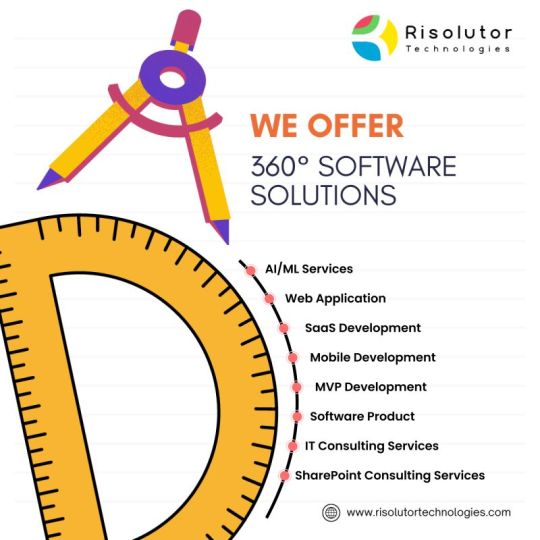
#mobile application development#sharepoint consulting company#custom software development services#web application development services
0 notes
Text
Future-Proof Your Business with SharePoint App Development Services
Stay ahead of the competition with Katpro Technologies' SharePoint application development services. Our forward-thinking solutions are designed to future-proof your business by leveraging the latest SharePoint capabilities. From advanced customization to seamless integration, trust our expertise to drive innovation and growth. Explore how our tailored SharePoint solutions can propel your business toward success in a rapidly evolving digital landscape.

0 notes
Text
Are You Frustrated With SharePoint? We Can Help

Tired of dealing with SharePoint frustrations? Moreyeahs provides the support and solutions you need to conquer your SharePoint challenges. For more info, visit: https://www.moreyeahs.com/services/microsoft-services/sharepoint/
#sharepoint development services#microsoft sharepoint development services#sharepoint application development services#sharepoint services
0 notes
Text
SharePoint: Empowering Businesses with Seamless Document Management and Accessibility
In today’s digital age, efficient document management and accessibility are essential for the smooth functioning of businesses. SharePoint, a powerful collaboration platform developed by Microsoft, serves as a centralized hub for document management, enabling organizations to store, organize, and share information seamlessly. With its array of features and capabilities, SharePoint empowers…

View On WordPress
0 notes
Text
#sharepoint consulting services#sharepoint consultants#sharepoint companies#sharepoint intranet consulting#sharepoint document management system#sharepoint onboarding checklist#sharepoint performance management#Sharepoint designer#sharepoint performance review#sharepoint website design#sharepoint design templates#sharepoint internal website#sharepoint solution#sharepoint intranet solution#sharepoint office 365#sharepoint designer#sharepoint services#sharepoint company#sharepoint application development#sharepoint online development#sharepoint business#sharepoint intranet design#sharepoint service#sharepoint design#office 365 share point#sharepoint expert consultant#uses for sharepoint
1 note
·
View note
Text
Maximizing Efficiency: The Power of Enterprise Integration Services by ThinkAI
Enterprise Integration Services empowers organizations to seamlessly connect and optimize their systems, data, and processes. This transformative approach enhances productivity, accelerates decision-making, and fosters innovation, ultimately driving business success in an interconnected world. Unlock your full potential with enterprise integration.
https://thinkaicorp.com/eai-integration-services/
#Enterprise Integration Strategy#Enterprise Integration Services Irvine#best Enterprise Integration Services Irvine#ChatBot Service#Sharepoint Integration#Microsoft Sharepoint Integration Services#Sharepont Service Irvine#Mobile App Development#Android App development#data integration#Application and data integration#core technology services#Healthcare IT
0 notes
Text
Top 10 Microsoft SharePoint 365 Tips and Tricks 2023!

SharePoint Online is a great tool for creating intranets, document management and integrating your Microsoft 365 apps. Like everything though, Microsoft SharePoint tips and tricks are needed if you want to get setup quickly. To build a professional intranet or DMS you will need the help of a SharePoint developer. However, there are tasks that can be handled in-house and handy SharePoint tips and tricks to help you manage SharePoint. That’s why we have put together this list of useful SharePoint 365 tips and tricks to help you out.
SharePoint 365 Tips and Tricks 1: Understand the SharePoint Site Architecture
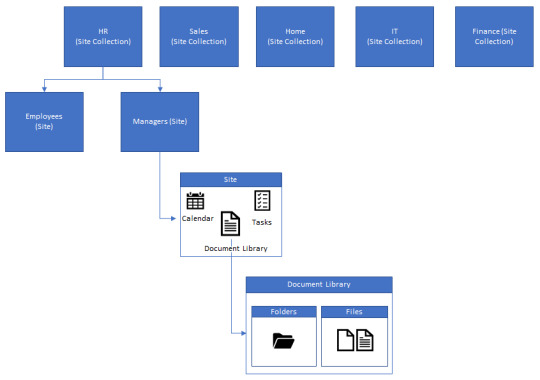
The first and most important thing to understand with SharePoint, is the architecture. It can be quite confusing to newbie’s how everything fits together with the other Microsoft 365 applications.
Overview
At a high-level, SharePoint works with a cascading structure. SharePoint sites are the top-level containers that house all content for a specific area (e.g a department like HR). These sites can contain subsites, document libraries, lists, web parts and pages.
Subsites – are used to house subsets of data for specific areas.
Document libraries – are used to store the sites documents.
Lists – are used to store data (like an online Excel spreadsheet). An example of a list could be a HR list of employee information.
Web parts – widgets that are used for functionality that can be embedded into a page.
Pages – are used to display content and information from lists and libraries.
Flat Structure vs Subsites
In the modern world of SharePoint, we have two possible ways of structuring SharePoint sites. Flat structure (recommended) and using subsites. Back in the old days of SharePoint, people used lots of subsites, sometimes going multiple levels deep. This caused SharePoint admins a nightmare to manage, as content was not easy to move and resulted in confusing navigation. So, flat structures were introduced. Creating all sites as ‘top-level’ sites and using hubsites to group them together (I will explain hubsites a bit later).
This is one of our favourite SharePoint 365 tips and tricks. People can often slip up by not knowing the recommended approach and it can be hard to rectify once you go down this path.
SharePoint 365 Tips and Tricks 2: Team site vs Communication site
Second on our list of Microsoft SharePoint tips and tricks, is the difference between SharePoint sites. In previous versions of SharePoint there were many site templates to choose from. Now in SharePoint 365 we just have two main ones. Team sites and communications sites.
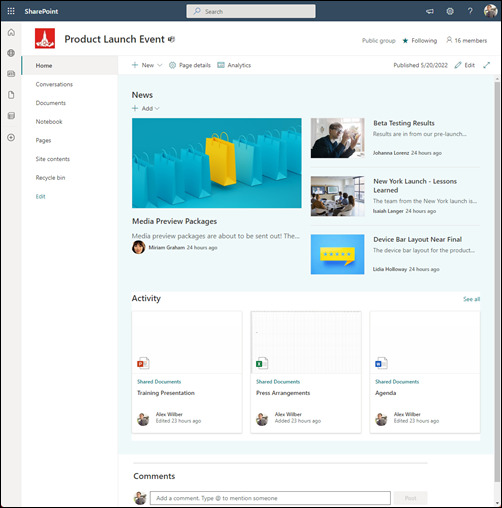
When creating a SharePoint site, we can use the team site template. They are mainly used for collaboration within a specific team, for a closed group, or limited amount of people. For example, if you work in the HR team and want a place to store and collaborate on documents for your team, this template should be chosen. Team sites, can be ‘group connected’, which bundles a SharePoint site together with other Microsoft 365 tools, like Teams, Outlook and OneNote. Or you can build a standalone Team site.
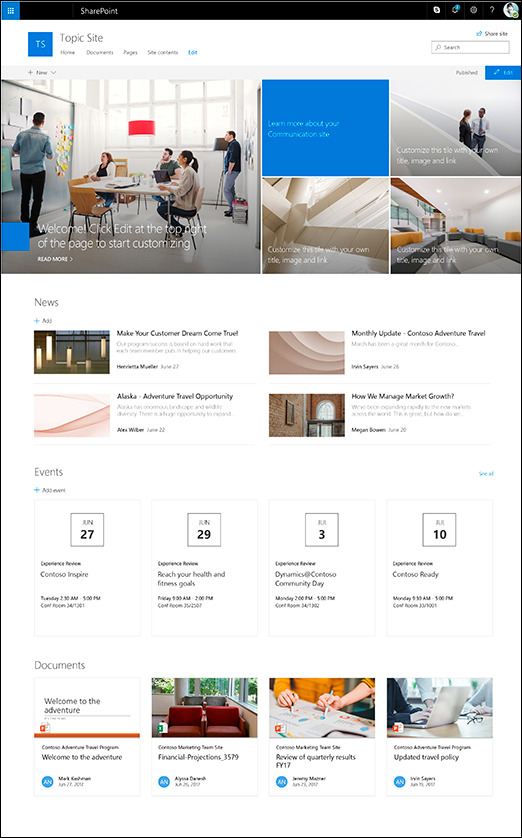
These site templates are generally used for information that will be displayed either company-wide, or to a large audience. The are most often used for intranets, to showcase information or display content in a more visually friendly way.
SharePoint 365 Tips and Tricks 3: Understanding integration between SharePoint and Teams
Understanding how SharePoint works with Microsoft Teams is very important in the modern workplace. This can sometimes be overlooked as an important tip, when describing how SharePoint works.
Teams is now a key part of many workplaces. It is used to chat with colleagues, video conferencing and collaborating on document within groups or ‘Teams’. When it comes to document collaboration, what most people aren’t aware of is that Teams is not much more than a user interface for SharePoint. When you create a new ‘team’ in Teams, this creates a new SharePoint site in the backend. All the documents you add and share within your team is stored in the SharePoint document library. For each channel you create within your team, this creates a new folder in your SharePoint document library. Which is used to categorise the content.
Lists vs Libraries
A very simple one of our Microsoft SharePoint tips and tricks to explain, but also something a lot of SharePoint newbies might not understand. What is the difference between a SharePoint list and a document library? Essentially, lists store content and libraries store files. Lists act like Excel or a database, to store and manage data. That data can then be used to develop apps, or create dashboards and reports to visualise and manage the data. Document libraries are purely containers for your document and folder structure, similar to working in file explorer on your laptop.
Using metadata to categorise your content
When setting up a new SharePoint library or list, you need to think about what metadata will be used, based on what it will be used for and structure it accordingly. If you ask any SharePoint developer for SharePoint 365 tips and tricks, this will come up, as it is a very important aspect of SharePoint.
For document libraries, there are two main ways of structuring content. Using a metadata structure, or a folder structure.
Metadata structure – the document or data is tagged with metadata, that is used to categorise the content. The metadata is filtered or searched to find the file you are looking for. For example you could have a date column and a department column and you could filter each column by the month and department you need to bring up all relevant documents. This structure is generally used for large libraries that need to be organised by multiple categorisations.
Folder structure – works just like your Windows file explorer, you use folders and subfolders to store files and organise them.
Microsoft SharePoint Tips and Tricks 6: Hub sites, home site and root site
As you start to get into the more advanced options within SharePoint, you will surely come across these three terms for sites, that seem quite similar. Let us break down what each one means.
Hub sites – as mentioned in ‘SharePoint 365 tips and tricks 1’, sites are often arranged in a ‘flat structure’ instead of using subsites to organise your content. However, the downside to this is you can end up with hundreds of rouge sites, not properly associated to similar sites. This is where hub sites come in. These are sites that are used to associate similar sites, to represent a structure.
Home site – this is generally set on the SharePoint site that is used for your intranet home page. This site tells users that this is the entry for your SharePoint intranet.
Root site – this is the default site that is created when setting up SharePoint, it cannot be deleted and is the site that is displayed under yourcomanyname.sharepoint.com
Microsoft SharePoint Tips and Tricks 7: Turbo Charging SharePoint with the Power Platform
SharePoint comes as part of the Microsoft 365 suite of products, so it integrates really well with the tools available in M365. However, there are three other Microsoft tools that can really super charge the Microsoft SharePoint functionality.
Power Automate – used for creating workflows within SharePoint and other Microsoft products. These workflows can be used to process data stored in SharePoint lists and libraries, to create anything from document approvals to complex business flows.
Power Apps – used to create mobile, desktop and tablet apps, that can be used as a custom user interface to display data from SharePoint lists and libraries.
Power BI – used to display your data into user friendly reporting dashboards to properly visualise data in graphs and charts.
Microsoft SharePoint Tips and Tricks 8: Permission structure and file sharing
SharePoint permissions can be a hard concept to grasp, as the permissions can get very granular and detailed. In short, access can be set at any level in SharePoint and cascades down from granting access to a SharePoint site, right down to granting access on individual files and folders.
Understanding your Branding Limitations
Back in previous versions of SharePoint, design and branding options were almost unlimited. You could use custom code to completely tailor your SharePoint page designs into anything you wanted. Although this is still possible in SharePoint online, one of our Microsoft SharePoint tips and tricks is not use this option. In modern SharePoint, Microsoft do not recommend doing so and there are very strict branding guidelines that should be followed. This is to avoid security risks and governance nightmares. Companies should now use SharePoint themes and templates to apply branding.
Uitilise Co-authoring
Although technically co-authoring is a feature of the Microsoft Office tools. It is a great SharePoint 365 tip, as it can be used to its full potential within SharePoint. Co-authoring provides the ability for multiple team members to collaborate on files together at the same time. Making changes in real time and even starting chats within the document.
Getting a grasp on managing SharePoint yourself is important for all SharePoint users. However, sometimes you do need a SharePoint expert to help out with tasks.
To get a quote for professional SharePoint consulting, click below.
#business application#digital workplace#employee engagement#employee experience#internet#microsoft#microsoft 365#microsoft office#microsoft teams#sharepoint#sharepoint development services#sharepoint online#tech news#technology
1 note
·
View note
Text
Sharepoint Backup Solution
A comprehensive data protection tool designed specifically for Microsoft SharePoint environments is called a SharePoint backup solution. By regularly producing backups, it protects crucial data housed in SharePoint sites, libraries, lists, and workflows.

Documents, configurations, permissions, and metadata may all be included in these backups. Through the provision of effective data recovery in the event of unintentional deletions, system failures, or cyber attacks, the solution ensures business continuity and compliance. It typically provides choices for off-site storage and features like automated scheduling and version history preservation. In order to improve data management and disaster recovery capabilities, SharePoint ecosystems must guarantee data availability and integrity.
0 notes